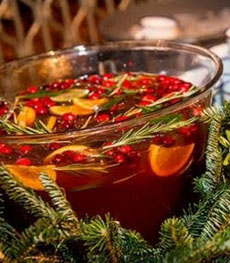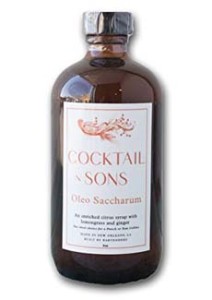TIP OF THE DAY: Make A Special Christmas Punch
|
When we first received this recipe, we thought: Readers of The Nibble won’t want to buy or make the oleo saccharum. Holiday season is busy enough as it is.
But we loved the recipe, and decided to make it for our own holiday celebration. We tasted the test batch and thought: We’ll be shortchanging our readers if we don’t share this. The recipe was created by Masahiro Urushido, an award-winning New York City bartender. He used Auchentoshan American Oak Single Malt Scotch, Rothman & Winter Orchard Apricot Liqueur and Lejay Creme de Cassis. This punch is inspired by traditional Scottish Christmas pudding, made with dried fruits such as raisins and apricots. Masa calls his recipe Pepperdier Christmas Punch, adapting the name of a friend. But since that can be confusing to the rest of us (we tried to research “Pepperdier” online), we’ll rename it slightly to Scotch Christmas Punch, acknowledging both the country of inspiration and the Scotch whisky in the recipe. Ingredients For 8 To 10 Servings |
 
TOP PHOTO: Christmas punch. Photo by Gabi Porter. BOTTOM PHOTO: Oleo saccharum, a big-sounding name for citrus sugar syrup. Photo courtesy Cocktail & Sons. |
|
|
*We happened to have a good bottle of Lambrusco—a red sparkling wine—on hand and it went great with this recipe. Most people will use Cava, Prosecco or another sparkling white wine. Preparation 1. SOAK the raisins in the Scotch for several hours or overnight. 2. MAKE the oleo saccharum if you aren’t purchasing it (recipe). 3. MIX all ingredients except the sparkling wine in a punch bowl. Garnish with rosemary, cranberries, orange slices and bay leaves. Top with sparkling wine and serve. If you don’t have a punch bowl, mix all ingredients except the sparkling wine in a pitcher. To serve, pour the punch into individual glasses, top with sparkling wine and garnish with an orange slice. |
||
|
|
WHAT IS OLEO SACCHARUM?
Oleo saccharum is citrus oil blended with sugar. In Latin, oleo means oil and saccharum means sugar. It became prominent in the 19th-century as a way to provide a subtle citrus flavor and aroma to sweetened drinks, instead of plain sugar syrup (simple syrup). Oleo saccharum is made from orange and/or lemon peels (lime peels have too much bitterness) that are muddled (crushed) to release the oils. Sugar is added to the muddled peel and mixes with the citrus oil that emerges from the skins. The peel is strained out, leaving sugared citrus oil. You can use it to add an elegant citrus note to any cocktail that requires sugar/simple syrup, and can blend it with club soda for a refreshing non-alcoholic drink. The bottled oleo saccharum from Cocktail & Sons, featured in the photo above, is a citrus syrup enriched with fresh lemongrass, toasted green cardamom and ginger. You can buy it on Amazon.com. Or, it’s easy enough to make your own. Here’s a recipe. Here’s something that few people outside the tea industry realize: Breakfast teas, notably English Breakfast, Irish Breakfast and Scottish Breakfast, are simply strong black tea blends. The blends have more flavor to stand up to milk or cream, complement British breakfast foods (eggs, porridge, ham, bacon, etc.) and provide heartiness (more body and caffeine) to energize the drinker in the morning. Afternoon tea blends tend to be lighter and smoother, to pair with sweets and tea sandwiches. |
|
|
The British first imported tea from China in the 17th century, to great public appreciation. Coffee was available at the time, but otherwise beer and stout were drunk by everyone, including children, because of contaminated water sources. The British became avid tea drinkers, and since the 18th century have been among the world’s greatest per capita tea consumers. In China tea is drunk plain, but in the 1720s, the British began to add sugar and milk or cream to create a more comforting beverage. Black tea came to exceed green tea in popularity, as it goes better with sugar and milk. (The same pattern occurred in the Thirteen Colonies.) In order of robust flavor and body: Thus, teas of the same name—English Breakfast, Earl Grey, Jasmine, etc.—can vary slightly in taste, aroma and appearance from vendor to vendor, and country to country. Names can also vary for the same type of blend. [Source] For example, fine tea vendor Harney & Sons calls its Scottish Breakfast Tea “Scottish Morn.” Describing the blend, which was made to the specifications of the American Scottish Foundation, Harney says: “A mixture of dark brown leaves, the smaller pieces of Assam and Ceylon and [the] CTC (cut, tear, curl) method make for a stronger tea. This is one of our darkest teas, brewing a very dark brown color. Many Scots would lighten it with milk. Aroma is not the point of this tea, so there are only hints of suggestions of malt. It is caffeinated [and] a very full bodied tea…perhaps the strongest tea we offer. Strong and simple, this tea is meant to be drunk with milk.” And now you know about Scottish Breakfast Tea and its kin, English Breakfast and Irish Breakfast. Enjoy the teas…and the punch!
|
||




